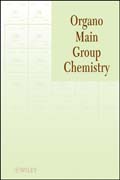
ÍNDICE: Chapter 1 Main Group Elements and Heteroatoms: Scope and Characteristics. 1.1 Aufbau Principle and Sign of Orbitals. 1.2 Electronic Configurationof an Atom: Main Group Elements and Heteroatoms. 1.3 Fundamental Property of Main Group Elements. 1.4 Acidity of Carboxylic Acid and Substituent Effect. 1.5 Heteroatom Effect. Chapter 2 Main Group Element Effect. 2.1 What is Main Group Effect? 2.2 Single Bond Energy and À-bond Energy. 2.3 Hypervalent Compound.2.4 Effect of Hypervalent Bond (1): 3c-4e Bond and Structure. 2.5 Effect of Hypervalent Bond (2): Apicophilicity and Pseudorotation. 2.6 Effect of Hypervalent Bond: Ligand Coupling Reaction (LCR) and Edge Inversion. 2.7 Effect of Ãx¯c. 2.8 Effect of Ã*x¯c. Chapter 3 Lithium, Magnesium, and Copper Compounds. 3.1 Synthesis. 3.2 Structure. 3.3 Reaction. Chapter 4 Boron and Aluminum Compounds. 4.1 Synthesis. 4.2 Structure. 4.3 Reaction. Chapter 5 Silicon, Tin, and Lead Compounds. 5.1 Synthesis. 5.2 Reaction. 5.3 Organotin and Lead Compounds. Chapter 6 Phosphorus, Antimony, and Bismuth Compounds. 6.1 Phosphorus Compounds. 6.2 Synthesis of Organophosphorus Compounds. 6.3 Tertiary Phosphine and Its Nucleophilic Reaction. 6.4 Arbuzov Reaction. 6.5 Perkow Reaction. 6.6 Synthesis of Optically Active Phosphine. 6.7 Ylide and Wittig Reaction and Related Ones. 6.8 Reaction of Phosphonium Salt and Formation of Phosphorane. 6.9 FreezingBPR and Its Effect. Chapter 7 Sulfur, Selenium, and Tellurium Compounds. 7.1 Sulfur Compound. 7.2 Synthesis of Organosulfur Compound. 7.3 Reaction of Organosulfur Compound. 7.4 Structure and Reaction of Hypervalent Organosulfur Compound. 7.5 Selenium and Tellurium Compounds. Chapter 8 Organohalogen Compound: Fluorine and Iodine Compounds. 8.1 Synthesis of Chlorine and Bromine Compounds.8.2 Fluorine Compounds. 8.3 Iodine Compounds. Chapter 9 Atrane and Transannular Interaction: Formation of Hypervalent Bond. 9.1 Introduction. 9.2 Silatraneand Atrane. 9.3 Transannular Interaction (1). 9.4 Transannular Interaction (2). Chapter 10 Unsaturated compound of Main Group Element of 3rd Period and Heavier. 10.1 Introduction. 10.2 Unsaturated Bonds of Group 15 Elements of 3rd Period and Heavier. 10.3 Unsaturated Bonds of Group 14 Elements of 3rd Period and Heavier. 10.4 Aromatic Compounds of Group 14 Elements. Chapter 11 Ligand Coupling Reaction. 11.1 Introduction. 11.2 Selectivity of Ligand Coupling Reaction: Theoretical Investigation. 11.3 Ligand Coupling Reaction of Organic Compounds of Phosphorus, Antimony, and Bismuth. 11.4 Ligand Coupling Reaction of Organic Compounds of Sulfur, Selenium, and Tellurium. 11.5 Ligand Coupling Reaction of Organoiodine Compound. Chapter 12 Hypervalent Carbon Compound: Can Hexavalent Carbon Exist? 12.1 Introduction. 12.2 Attempts for Pentacoordinate Hypervalent Carbon Species. 12.3 Synthesis of Pentacoordinate Hypervalent Carbon Species (10-C-5) and Bond Switching at Carbon and Boron. 12.4 Attempts to Hexacoordinate Hypervalent Carbon Species (12-C-6).
- ISBN: 978-0-470-45033-8
- Editorial: John Wiley & Sons
- Encuadernacion: Rústica
- Páginas: 250
- Fecha Publicación: 01/07/2011
- Nº Volúmenes: 1
- Idioma: Inglés
